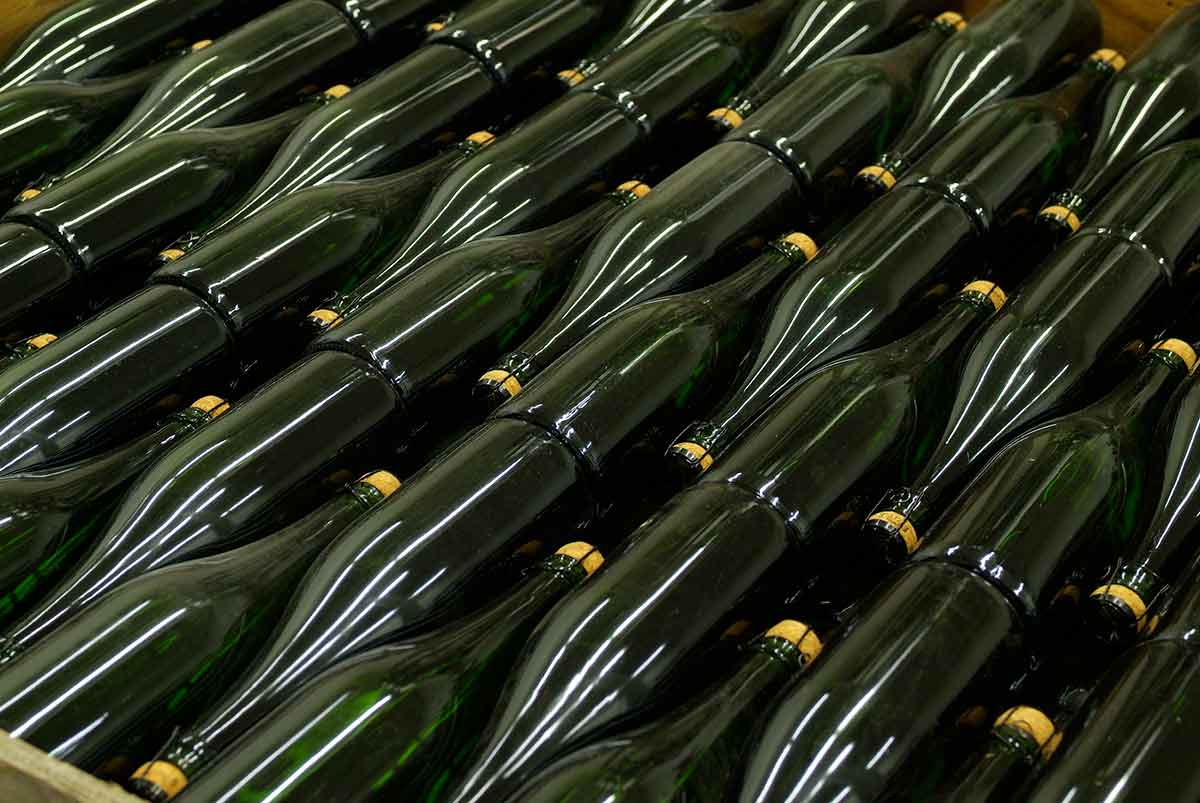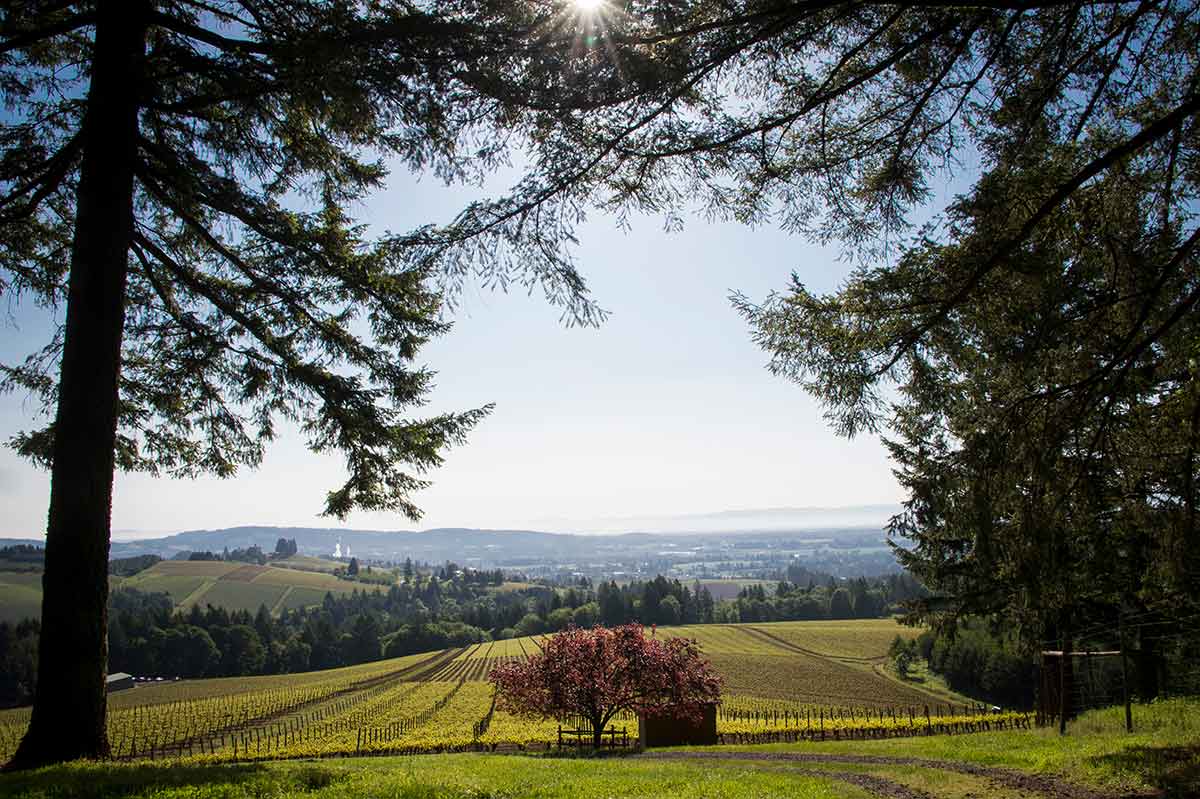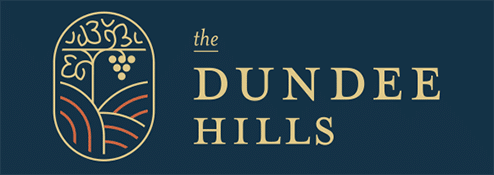Sparkling Wines of the Dundee Hills
A History and Guide to Sparkling Wine
Believe it or not, bubbles were not always loved by winemakers and connoisseurs. Called “The Devil’s Wine” by some critics, the effervescence we love today would give Old World winemakers fits centuries ago as their cool region bottles would re-ferment in the summertime, resulting in much irritation and… bubbles. In fact, the famous Dom Pérignon was instructed by members of the Abbey of Hautvillers to eliminate the bubbles in his wine because they were causing so many bottles to burst in the cellar.
 Of course times and tastes have changed since the 1600’s and now sparkling wine is loved across the globe – from France’s Champagne to Spain’s Cava to Italy’s Prosecco to sparkling wine produced in the United States. Its popularity is reflected in both wine sales and in the number of wineries producing sparkling wine.
Of course times and tastes have changed since the 1600’s and now sparkling wine is loved across the globe – from France’s Champagne to Spain’s Cava to Italy’s Prosecco to sparkling wine produced in the United States. Its popularity is reflected in both wine sales and in the number of wineries producing sparkling wine.
The wine world has come to realize that occasions for sparkling wine have evolved and aren’t just for celebrations anymore. These wines are versatile, pair wonderfully with everything from seafood to barbecue to dessert, and are the perfect way to make any day feel special. And hasn’t that been a welcome gift this past year!
Every region around the world makes their sparkling wine through a unique process, but a few key factors are shared in common across the globe. For some, the sparkling wine process actually begins in the vineyard by farming specifically for sparkling wine. Next, the grapes for are harvested early so they’re more acidic than sweet. While a sweet grape is desirable for Pinot Noir, Chardonnay and other varietals the Dundee Hills is known for, that’s not the case with sparkling.
Second, winemakers take extreme care to avoid tannins, and often handpick their grapes to avoid risk of them splitting, which would cause the juice to mingle with the skins. The most commonly used varietals in Willamette Valley sparkling wine in the Dundee Hills are Chardonnay and Pinot Noir.
Next, the wine begins its first fermentation in a vessel that allows the carbon dioxide to escape, which is not unlike a still wine. After fermentation, the wines are often blended together into a cuvee, though many varietal-specific sparkling wines do exist in the Dundee Hills.
The second fermentation is where the process diverges from still wine – and it’s where many regions and wineries tailor their own unique process (more on that below). In the second fermentation, winemakers are careful to ensure the carbon dioxide remains trapped and is absorbed back into the wine, which creates the bubbles we all love. Because of the high pressure, the wine bottles are made of an extra thick glass. And once the cork is popped, the CO2 gas releases and the wine becomes effervescent.
Méthode Traditionnelle in the Dundee Hills
Many of the Willamette Valley sparkling wine producers in the Dundee Hills adhere to the traditional method, which was developed in France (méthode traditionnelle) and is the method by which all true champagnes are crafted.
In the traditional method, the first fermentation is done in a large vessel – most often a tank or a barrel – before it goes into the bottle for the second fermentation along with liqueur de tirage, a combination of yeast, sugar and wine that prompts the creation of carbon dioxide. As the wine undergoes this second fermentation, the yeast precipitates out (called the lees). The wine then ages on the lees (called en tirage), which adds the rich, bready notes we savor in sparkling wine. After the bottles have aged, sometimes for years, they are aggressively inverted and regularly repositioned in a process called riddling that forces the lees to make its way to the neck of the bottle.

The lees must be removed before the wine can be enjoyed. The necks of the wine are frozen, the bottles are returned to their upright position and the temporary cap is removed. The pressure within the bottle forces out the frozen block of lees and the bottle is then secured with the cork and halter.
It’s quite the process, but the excellent sparkling wines in the Dundee Hills are well worth the effort!
Sparkling Wine-Centric Experiences in the Dundee Hills:
The Dundee Hills may be known for Pinot Noir, but the sparkling wine from the region is exceptional and worthy of exploration. Argyle Winery was one of the first to produce Oregon sparkling wine in 1987, but now a number of the Dundee Hills winemakers have turned their hand to producing bubbles. And they’re receiving both national and global recognition for their efforts!
Here’s your opportunity to learn more about the nose-tickling wines and the experiences waiting for you to try!
Argyle Winery
- Varietals: Pinot Noir, Chardonnay and Pinot Meunier
- Production began in 1987, showing their dedication to sparkling wine from the very beginning. They farm for sparkling wine, they have our winery set up for sparkling wine, and they make 12-15 different sparkling wines–all with different blends, time in bottle, dosage levels. And they are always thinking of new ideas.
- Sparkling wines are available in their tasting room to enjoy, as are their Master of Sparkling classes and their sparkling wine club.
- Visit Argyle Winery
Cramoisi Vineyard
- Varietal: Pinot Noir
- Their first vintage will be produced this year, and will be a small batch Oregon version of Grower’s Champagne made in the traditional method with the blend of our Pinot noir clones.
- Tastings will be available two months of the year, currently planned for August and October.
- Visit Cramoisi Vineyard
De Ponte Cellars
- Varietals: Pinot Noir, Chardonnay, Melon de Bourgogne (all separately bottled)
- Production began in 2015. They craft small lots of traditional method sparkling wines that personify our unique terroir and the varietals grown.
- Sparkling wines are available in their tasting room to enjoy!
- Visit De Ponte Cellars
Dobbes Family Estate
- Varietals change every year with their Elements series. They’ve used Chardonnay, Pinot Noir and Grenache Blanc.
- Production began in 2016 as a way to support environmental advocacy through the sales of their Elements program. They change the style every year to allow for winemaker creativity and give their guests something new to look forward to.
- Sparkling wines are available in their tasting room to enjoy!
- Visit Dobbes Family Estate
Domaine de Broglie
- Varietals: Pinot Noir with Chardonnay dosage
- Production began in 2018 because they love sparkling, and thought high elevation Dundee Hills would be a great place to show off Oregon sparkling wine. This is small production, made in simple traditional style, and it’s all about the vineyard.
- Sparkling wines are available in their tasting room and new sparkling wine experiences are expected soon!
- Visit Domaine de Broglie
Domaine Serene
- Varietals: Pinot Noir and Chardonnay
- Production began in 2019 with the ‘Evenstad Reserve’ Brut M.V. 1 Sparkling Wine, crafted at Oregon’s first dedicated “White Winery” used solely for the production of sparkling wine and Chardonnay. Domaine Serene will produce a total of seven sparkling wine offerings over the next decade from their renowned estate vineyards.
- Sparkling wines are available in their tasting room and a sparkling flight is available at their Wine Lounge in Lake Oswego.
- Visit Domaine Serene
Furioso Vineyards
- Varietals: Pinot Noir and Chardonnay
- Production began in 2017 because many on their small team of seven love méthode champenoise sparkling and wanted to help produce some small batch wines that could be disgorged on demand. They produce a rosé of Pinot Noir and Chardonnay, a blancs de blancs from Chardonnay, and a “Blancs de Pinot” from Pinot Noir. All are small batch and the current release is a 2017 Rosé 31 months en tirage.
- Sparkling wines are available in their tasting room and more exciting experiences could be coming in the near future!
- Visit Furioso Vineyards
Lange Estate Winery & Vineyard
- Varietals: Pinot Noir and Chardonnay
- Production began in 2015, believing Oregon to be capable of producing world-class sparkling wines. The Mia Mousseux Brut Rosé is sourced from the highest elevation block named the Mia Vineyard. As with all their estate vineyards, Mia is sustainably farmed and is LIVE and Salmon Safe Certified.
- Sparkling wines are available in their tasting room to enjoy!
- Visit Lange Estate Winery
Native Flora
- Varietals: Pinot Noir and Pinot Blanc
- Production began in 2011 because they enjoy traditional champagne from the small grower producers in France and wanted to bring that taste and texture of handmade production to the Oregon sparkling wine market. They use a proprietary blend of estate Pinot Noir and Pinot Blanc and also offer extended tirage times of 4-10 years.
- Sparkling wine is sometimes part of their tasting experience, but on a limited basis due to limited production.
- Visit Native Flora
ROCO Winery
- Varietals: Pinot Noir and Chardonnay
- Winemaker Rollin Soles released the 2013 vintage RMS sparkling wine in 2016. Visionary from the beginning, he came to Oregon in 1986 to prove, from the ground up, that the Willamette Valley is the New World’s premier sparkling wine region. He believed the marine-influenced landscape north of the 45th parallel could grow the crisp, fresh-fruited Pinot Noir and Chardonnay needed to produce world-class sparkling wine in the tradition of Champagne. Now more than three decades into this craft, he has the most experience of any winemaker in the region with Oregon bubbles.
- Sparkling wines are available in their tasting room and they periodically offer sparkling wine experiences through the Best Oregon Bubbles (BOB) Trail.
- Visit ROCO
Sokol Blosser
- Varietals: One is 100% Pinot Noir, the other is Pinot Noir, Chardonnay, Early Muscat, Muller-Thurgau, and Riesling.
- Production began in 2011. Alex and Alison Sokol Blosser always loved the style, and after a disastrous experiment with a soda stream and white wine, they decided to try and make it for real! Their sparkling wines are made in the Champagne method, with the Bluebird Sparkling Cuvée spending 12 months en tirage and the Sparkling Rosé spending 32 months en tirage.
- Sparkling wines are available in their tasting room to enjoy!
- Visit Sokol Blosser
Stoller Family Estate
- Varietals: Pinot Noir and Chardonnay
- Production began in 2013 when the ability to make sparkling wine became more accessible, which gave them the confidence to produce outstanding wines from their site. Their sparkling wines are very site specific, from their home in the Dundee Hills. There’s a lot of care that goes into the Stoller program to create expressive wines in the traditional method.
- Sparkling wines are available in their tasting room and a special flight is available in the month of February.
- Visit Stoller Family Estate
Winderlea Vineyard & Winery
- Varietals: Pinot Noir and Chardonnay
- Winderlea began making sparkling wine in 2016 and continues to do so using the traditional Champagne method. The 2017 Vintage Sparkling Brut is bright and perfumed with notes of crisp pink lady and green apples, citrus zest and a touch of brioche or pie crust.
- Sparkling wines are available in their tasting room, and the Vintage Sparkling Brut is available by the glass and is usually available to try on monthly flights.
- Visit Winderlea
Resources to Explore
- Wine Spectator: How Sparkling Wine is Made
- VinePair: All the Ways to Make Champagne and Sparkling Wine, Explained
- RichardPeterson.com: Glossary of Champagne Terms
- Glass of Bubbly: How to Taste Champagne & Sparkling Wine Like a Pro

